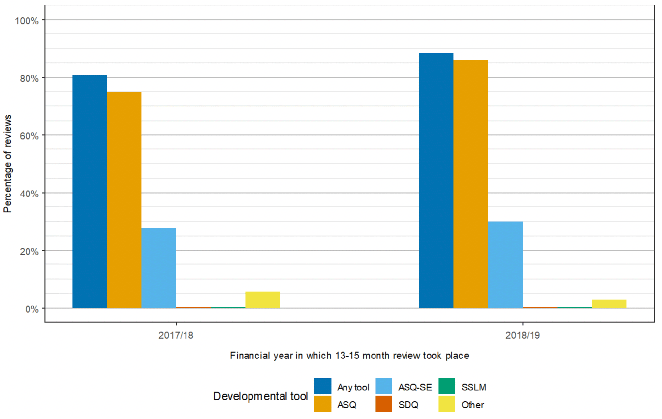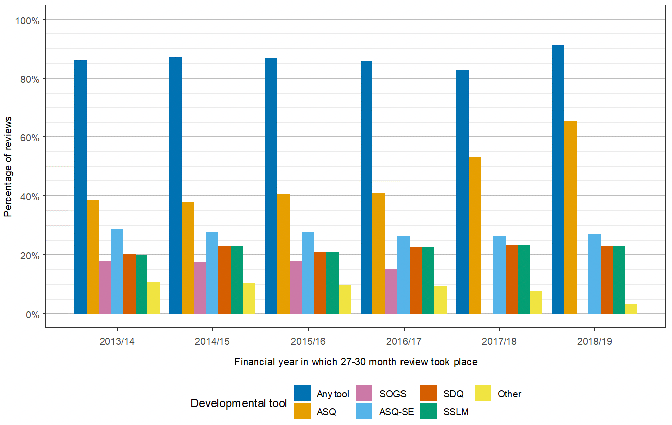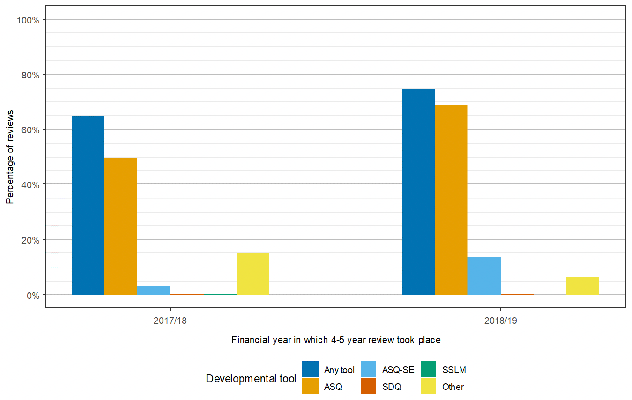Universal Health Visiting Pathway evaluation: phase 1 report - routine data analysis - implementation and delivery
The Universal Health Visiting Pathway was introduced in Scotland in 2015 to refocus the approach to health visiting in Scotland. This is the final report of four that provides findings about the implementation and delivery of the pathway as part of the national evaluation of Health Visiting.
Developmental tools used in review
For the last three child health reviews, validated assessment tools were used to assess children's development. Initially, when the 27-30 month review began in April 2013, several developmental tools were approved for use during the review and were described in the clinical guidelines, but no one specific tool was recommended. In practice, prior to the introduction of the UHVP, more than one tool was often used during a review. However, in 2015 the UHVP recommended that the Ages and Stages Questionnaire (ASQ 3) should be used in the assessment of the child's development in the 13-15 month, 27-30 month and 4-5 year reviews. The use of Ages & Stage Questionnaire: Social-Emotional (ASQ-SE 2, which measures additional elements of social and emotional development) was also approved as an additional tool for use in the UHVP.
13-15 month review
As described above, data for this review were only available for two years (see Figure 28). In 2017/18, of 25,182 reviews conducted, 74.9% used the ASQ and 27.7% used ASQ-SE2; less than 6% used another (unknown) tool. In 2018/19, the number of practitioners using ASQ and ASQ-SE had increased to 86.0% and 30.1% respectively; less than 3% used a different tool. It should be noted that percentages do not add to 100% as more than one tool can be used within the reviews.
27-30 month review
The distribution of developmental assessment measures for this review are displayed in Figure 29. Over the six-year period, a developmental assessment tool was used in 83%-91% of reviews. In about 20% of reviews, the Strengths and Difficulties Questionnaire (SDQ) and Sure Start Language Measure (SSLM) were used – this is primarily accounted for by NHS Greater Glasgow & Clyde, where these were the primary assessment tools. The Schedule of Growing Skills (SOGS) was used in 15.1%-17.9% of reviews until 2016/17. The percentage of other tools used in reviews decreased over the six year period, from 10.8% to 3.4%. The use of ASQ was approximately 40% for the first four years until the introduction of the UHVP; in the final two years, a substantial increase in the recorded use of ASQ can be observed, reaching 65.3% in 2018/19.
4-5 year review
Again, data for this review is only available for two years. The percentage of reviews in which a developmental assessment tool was used increased in 2018/19: likewise the percentage of reviews in which the ASQ was used increased from 49.7% in 2017/18 to 68.8% in 2018/19, and the percentage in which other assessment tools were used decreased from 15.1% to 6.3% (see Figure 30).



Notes to Figure 28-30
ASQ Ages and Stages Questionnaire
ASQ-SE Ages and Stages Questionnaire: Social and emotional
SDQ Strengths and Difficulties Questionnaire
SOGS Schedule of Growing Skills
SSLM Sure Start Language Measure
1. See Table 1 above for the number of reviews delivered in each financial year. If fewer than 1,000 reviews were delivered in a financial year, data for that year have not been analysed (e.g. for the 13-15 month review, 125 were conducted in 2016/17; for the 27-30 month review, 296 were provided in 2012/13; and for the 4-5 year review, 19 were provided in 2016/17).
Source for Figure 28-30
The source for all child health data is CHSP-PreSchool May 2020, Public Health Scotland. The source for births data is NRS.
Contact
Email: justine.menzies@gov.scot
There is a problem
Thanks for your feedback